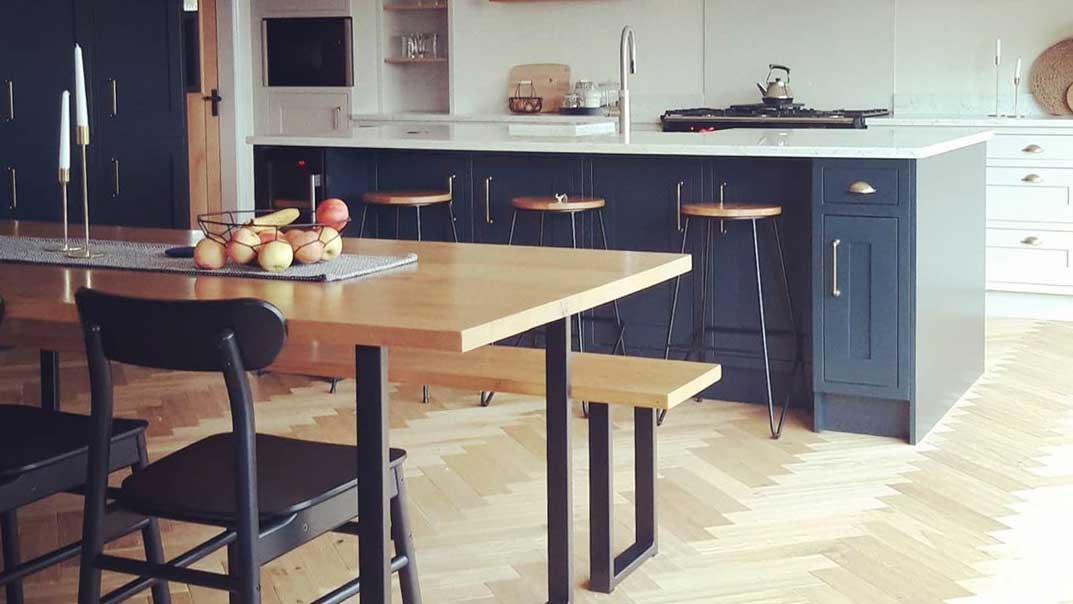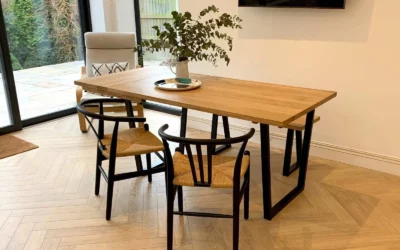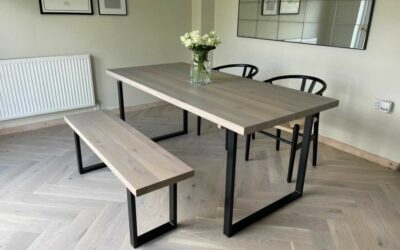The Ultimate Guide To Staining Wood
There are many different finishes to consider on your solid wood table, with wood stain becoming an increasingly popular choice. If you’ve decided to use a wood stain, we’ve pulled together everything you need to know to make your table the centrepiece of your home.
Contents
What Is Wood Stain?
Wood stain is a semi-transparent coating that penetrates the wood to provide colour whilst also allowing features of the wood, such as colour and grain effects, to remain visible.
Stain works by soaking pigment into wood fibres with a solvent and then having it set and bind into the wood. Whilst stain does offer some level of protection against UV rays, it saturates colour into the wood itself rather than applying a layer of colour on top of the wood, which means it’s mainly used for decorative purposes.
Stain comes in varying different colours, including non-wood shades, however, the most popular choices are often found in timber shades such as Oak, Mahogany and Teak. This is so the wood maintains its authentic appearance whilst enhancing its natural beauty.
Where extra durability is required, it is recommended to use a protective clear topcoat in conjunction with a wood stain, such as varnish, to get the best results.
The Advantages And Disadvantages Of Wood Stain
As with any finish you can choose for your solid wood dining table, there are advantages and disadvantages when it comes to selecting a wood stain.
Advantages
- Highlights the authentic wood colour and texture. Many people opt for a solid wood dining table due to the natural beauty of solid wood so it’s no surprise that wood stains are selected to help highlight the grain and colour.
- There’s a varied choice in colour. Whether you want a clear stain that just enhances the natural beauty of the wood or a tinted stain so that your table will match other furniture in your home, there are plenty of options to choose from.
- It’s easy to do yourself. The beauty of staining wood is it’s simple and easy to do yourself at home, whatever your ability.
Disadvantages
- It doesn’t provide long term protection. Whilst stain can offer some protection against UV rays, which can cause the wood to fade and discolour over time, it doesn’t protect the wood against water, scratches and general wear and tear.
- Whilst some stains can last up to five years if stain used without a protective topcoat on a solid wood table that is regularly used
- It can be tricky to remove a wood stain. As the stain penetrates the wood, unlike paint which sits on the wood surface and can be sanded off, a stain is a lot trickier to remove.
👉 “Considering A New Dining Table?“
Our stunning dining tables are handmade with love and come in a wide range of styles; from contemporary to rustic and farmhouse styles.
Different Type Of Wood Stains
There are many different options available on the market when it comes to wood stain, from oil-based and gel to water-based and varnish wood stains. There’s no right or wrong answer when it comes to choosing a wood stain, it all depends on the desired finish look and the level of protection you require.
Oil-based wood stain
Oil-based wood stains are the most popular choice when it comes to choosing a stain, due to their durability and deep penetration. Oil-based stains tend to have a slower drying time than other wood stains which may put people off, however, makes it easier to get an even finish.
Water-based wood stain
Water-based wood stains are a great choice for those that are more environmentally friendly, as they contain less polluted articles. However, this type of stain doesn’t penetrate the wood as deeply as oil-based stains and dries very fast so can be difficult to apply – for large surface areas it’s best to split this into sections to allow even application.
Varnish wood stain
Varnish wood stains are very similar to oil-based stains with one difference – they dry hard. They tend to be more difficult to apply than other stains as there’s less time to wipe off the excess, usually within 15 minutes, compared to oil-based stains which need to be wiped away before it dries.
Gel wood stain
As gel wood stains come in a jelly-like form, it keeps the stain even and doesn’t flow or leak like other stains. Whilst this makes the application a lot easier, gel wood stains don’t penetrate the wood as deeply as oil-based stains and can take a long time to dry.
How To Apply Wood Stain To Your Furniture?
When it comes to adding a finish to your wooden furniture, like with anything, preparation is key. Regardless of what stain you choose, failing to correctly prep the wood beforehand will affect the final result. Follow these key steps on applying wood stain and you won’t go wrong:
- Use a brush, either natural bristle or soft nylon, to remove any dust or debris.
- Sand your wood until the surface is smooth – this is probably one of the most important stages and will dictate how even your finish is. You might need to start with a coarse paper then work your way up to a finer paper (120-150 grit) depending on how much preparation there is to do. Remember, if you leave the surface too rough, the wood will absorb more stain and have a darker finish.
- Once you’ve finished sanding, dust the wood with a clean and dry brush and using a clean, damp cloth, wipe the wood clean.
- Once your area is dry, you can apply the wood stain. The nature of what stain you’ve opted for will determine the best type of brush to use so follow the manufacturer’s instructions on the tin. Generally, we recommend using a synthetic brush for water-based products and a natural bristle brush for anything solvent based.
- Allow drying according to the instructions
With so many different options to choose from, you’ll be sure to find a wood stain that works for you. Remember, every piece of wood is unique and different so you must always test a sample of the stain you’re using. Wait for the stain to dry properly so you can see the finished results – the colour often changes from application and throughout the drying process. You may also find our guide on how to care and maintain your oak furniture interesting.
Considering A New Dining Table?
Our stunning dining tables are handmade with love here in the UK and come in a wide range of styles; from contemporary to rustic and farmhouse styles. We're certain you'll find one that looks great in your home.
Just give them a view at the very least 🙂








